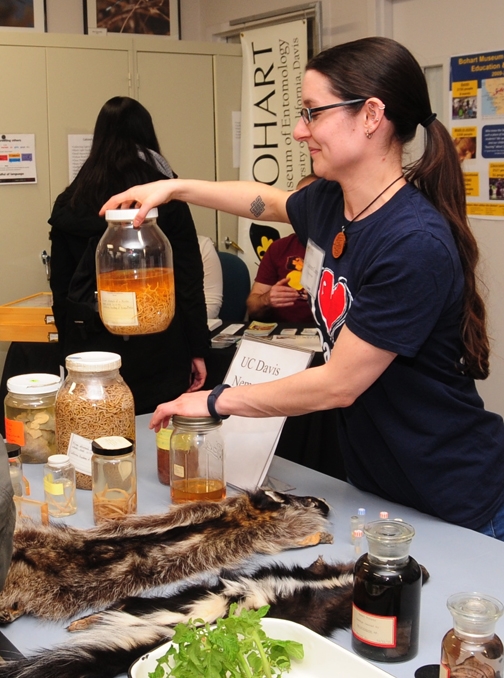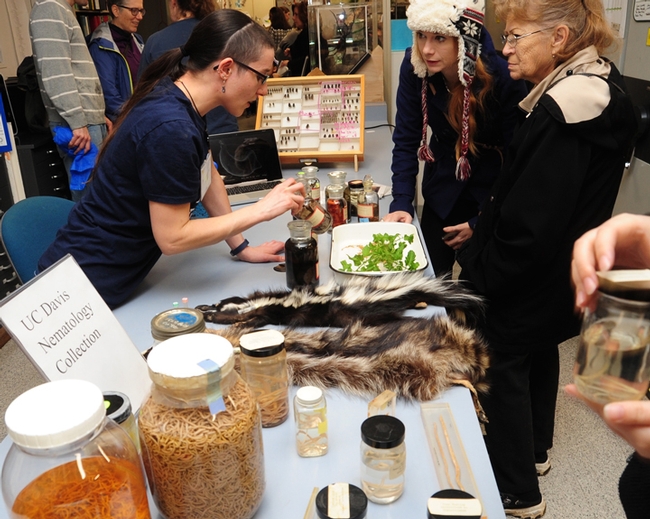
UC Davis nematologist/parasitologist Lauren Camp gets asked that a lot.
In one word: "Worms."
Her display table last Sunday, Jan. 22 at the Bohart Museum of Entomology's "Parasite Palooza" open house drew dozens of fascinated visitors of all ages.
“Nematodes are an amazing phylum of organisms--they exist in almost every known environment on the planet, and different species eat everything from bacteria and fungi to plant and animal tissue," said Camp, who received her doctorate from UC Davis last December, studying with nematologist Steve Nadler, professor and chair of the UC Davis Department of Entomology and Nematology.
"I find parasites particularly fascinating, because they are dependent on another organism (or organisms) for part or all of their life cycle."
Camp staffed the table from 1 to 4 p.m., enthusiastically answering all kinds of questions and talking about her displays, which included nematodes from the stomach of a Minke whale (specimen from the California Academy of Sciences), the heart of a dog (pointer) infected with heartworm, and a tomato plant with nematode-damaged roots.
"I got a lot of That's gross! and That's cool!" Camp recalled. "People were amazed by the whale stomach worms. Many were saddened by the dog heart infected with heartworm, but understood the importance of giving their dogs medication for heartworm."

Regarding heartworm (Dirofilaria immitis) in dogs, Camp pointed out that the parasite is transmitted to dogs through mosquito bites, and more than 70 mosquito species can transmit it. Dirofilaria immitis is distributed across the United States, although its prevalence is higher in some U.S. regions, she said. A good resource? Check out https://www.capcvet.org/capc-recommendations/canine-heartworm/, a website that also includes maps of prevalence in the U.S. from 2011 and 2012.
The tomato plant, infected with Meloidogyne incognita, came from postdoctoral fellow Rasa Cepulyte-Rakauskiene of the Valerie Williamson lab, UC Davis Department of Plant Pathology. "Meloidogyne species
Camp, who hails from rural northern Indiana, first became interested in parasites as an undergraduate student at the University of Chicago, where she received her bachelor's degree in biology in 2005. She went on to earn her master's degree in biology from Wake Forest University in 2007. "My specific interest in nematode parasites developed when I read some of Dr. Nadler's work on the evolutionary relationships of nematodes for an invertebrate biology class. Her career plans: a researcher in infectious diseases or genetics/genomics or as a science communicator.
Meanwhile, if you missed Camp's presentation at the Bohart Museum open house, not to worry. She's booked one more presentation this month and nematologists will table an event at the UC Davis Biodiversity Museum Day.
Science Night Live Program: Camp will speak on "Nematode Need-to-Know: Roundworms Are All Around You” at the Science Night Live Program at 6 p.m., Wednesday, Feb. 1 at the World of Wonders (WOW) Science Museum, 2 North Sacramento St., Lodi. The two-hour event is billed as a “conversation with the parasitologist.” She will display nematodes ranging in size from less than one millimeter to eight meters long, or 30 feet.
UC Davis Biodiversity Museum Day. Nematologists Corwin Irwin and Chris Pagan, both graduate students, will discuss and show nematodes from noon to 4 p.m. in the Sciences Lab Building, UC Davis campus. This will be a part of 12 collections on display throughout the campus. The event, open from 9 a.m. to 4 p.m. (some collections are open from 9 to noon, and some from 1 to 4 p.m.) will "showcase natural history, biodiversity and the cultural-ecological interface," according to Biodiversity Museum Day coordinator Tabatha Yang, education and outreach coordinator for the Bohart Museum of Entomology. (See Bug Squad blog)
Camp also appeared Sunday, Jan. 22 on Good Day Sacramento's "Parasite Palooza" show with entomologist Jeff Smith, curator of the moth and butterfly specimens at the Bohart Museum of Entomology. They shared and showed specimens and live insects. Camp mentioned a 30-foot-long whale nematode. (See http://gooddaysacramento.cbslocal.com/video/category/spoken-word-good-day/3610653-parasite-palooza/) She also spoke Feb. 1 to Capital Public Radio. See http://www.capradio.org/88726.
"It's fun to talk about nematodes with the public," she said.
Attached Images:

UC Davis nematologist/parasitologist Lauren Camp discusses her specialty with a visitor at the Bohart Museum's open house. (Photo by Kathy Keatley Garvey)

Lauren Camp kept visitors fascinated at the Bohart Museum's "Parasite Palooza." (Photo by Kathy Keatley Garvey)

UC Davis scientist Baohua Li of the Department of Plant Sciences, and his wife, Yao and daughter Annie, 2, check out the nematodes. (Photo by Kathy Keatley Garvey)